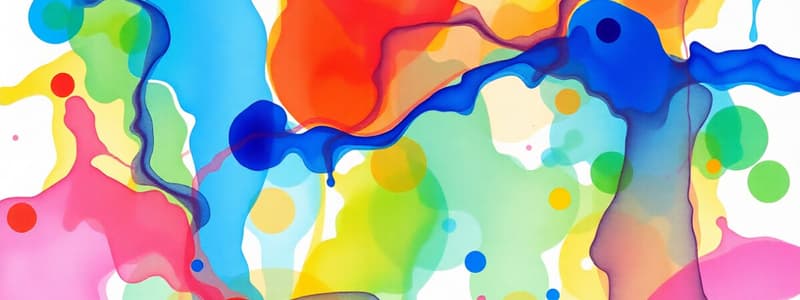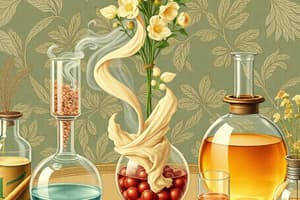Podcast
Questions and Answers
What physical property is primarily used in paper chromatography to separate pigments?
What physical property is primarily used in paper chromatography to separate pigments?
- Melting point
- Particle size
- Solubility (correct)
- Density
Filtration is effective for separating a soluble solid from a liquid solution.
Filtration is effective for separating a soluble solid from a liquid solution.
False (B)
What method is used to separate two immiscible liquids using density?
What method is used to separate two immiscible liquids using density?
Decanting
______ is a method that separates a soluble solid from a solution using boiling point.
______ is a method that separates a soluble solid from a solution using boiling point.
Match the separation method with its primary physical property:
Match the separation method with its primary physical property:
Which of the following separation methods is not dependent on boiling point?
Which of the following separation methods is not dependent on boiling point?
Distillation can separate at least one solvent from a mixture based on its average density.
Distillation can separate at least one solvent from a mixture based on its average density.
Name the method utilized to guide liquid into a collection container when separating two distinct layers in a suspension.
Name the method utilized to guide liquid into a collection container when separating two distinct layers in a suspension.
What is the primary purpose of simple distillation?
What is the primary purpose of simple distillation?
Fractional distillation is used when the boiling points of the liquids are significantly different.
Fractional distillation is used when the boiling points of the liquids are significantly different.
What is collected at the end of the condenser during simple distillation?
What is collected at the end of the condenser during simple distillation?
In fractional distillation, the __________ column is used to separate liquids with close boiling points.
In fractional distillation, the __________ column is used to separate liquids with close boiling points.
What happens to the vapor that has a constant temperature during fractional distillation?
What happens to the vapor that has a constant temperature during fractional distillation?
In simple distillation, the thermometer is used to monitor the temperature of the liquid in the distilling flask.
In simple distillation, the thermometer is used to monitor the temperature of the liquid in the distilling flask.
What is the first liquid collected during fractional distillation called?
What is the first liquid collected during fractional distillation called?
Match the types of distillation with their descriptions:
Match the types of distillation with their descriptions:
Flashcards
Simple Distillation
Simple Distillation
A separation technique used to isolate a solvent from a solution by heating the mixture until the solvent vaporizes, then condensing the vapor to collect the pure solvent.
Distillate
Distillate
The liquid collected at the end of the condenser during distillation, representing the purified solvent.
Fractional Distillation
Fractional Distillation
A separation technique used to isolate multiple miscible liquids from a mixture by exploiting their different boiling points.
Fractionating Column
Fractionating Column
Signup and view all the flashcards
Volatile Solvent
Volatile Solvent
Signup and view all the flashcards
Boiling Point
Boiling Point
Signup and view all the flashcards
Condensation
Condensation
Signup and view all the flashcards
Miscible Liquids
Miscible Liquids
Signup and view all the flashcards
Paper Chromatography
Paper Chromatography
Signup and view all the flashcards
Filtration
Filtration
Signup and view all the flashcards
Decanting
Decanting
Signup and view all the flashcards
Crystallization
Crystallization
Signup and view all the flashcards
Distillation
Distillation
Signup and view all the flashcards
Filtration
Filtration
Signup and view all the flashcards
Decanting
Decanting
Signup and view all the flashcards
Paper Chromatography
Paper Chromatography
Signup and view all the flashcards
Study Notes
Mixture Separation Methods
- Pure substances in mixtures can be separated physically because no new compounds are formed.
- Separation methods depend on the physical properties of mixture components and the desired component.
Paper Chromatography
- Principle: Solubility differences between the solvent and the pigments.
- Use: Separating and identifying pigments in inks and dyes.
- Process: Solvent travels up paper; pigments dissolve. Pigments travel at different speeds based on their solubility in the paper and solvent.
- Solubility Indicator: Distance travelled indicates pigment solubility in the mediums.
Filtration
- Principle: Particle size differences.
- Use: Separating a solid from a liquid in a suspension.
- Process: Liquid passes through holes in a filter while solid (insoluble material) is retained.
Decanting
- Principle: Density differences.
- Use: Separating liquids of different densities or immiscible liquids.
- Process: The denser component settles; the less dense liquid (the solvent) is poured off.
- Equipment: Separating funnel.
Crystallization
- Principle: Differences in boiling points.
- Use: Separating a soluble solid from its solution.
- This method ensures that the solid is separated and the solvent is recovered.
Distillation
- Principle: Differences in boiling points.
- Use: Separating components in mixtures, recovering solvents, separating multiple liquids.
- Types: Simple and Fractional.
Simple Distillation
- Use: Separating solvents or separating solvent and dissolved solids.
- Process: Mixture heated to solvent's boiling point; solvent vaporizes. Vapor rises, flows through condenser as cold water cools the vapor—creating a liquid distillate. This repeats until all the solvent is collected
Fractional Distillation
- Use: Separating multiple miscible liquids with closely-spaced boiling points.
- Process: Utilizes a fractionating column, which allows for multiple vaporization and condensation cycles within the column.
- Result: Over time, the more volatile (lower boiling point) liquid dominates the vapors at the top of the column. This pure vapor is condensed and collected, the temperature monitored, and the process repeated for consecutive liquids.
Studying That Suits You
Use AI to generate personalized quizzes and flashcards to suit your learning preferences.



